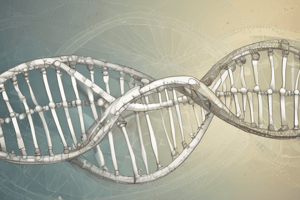Podcast
Questions and Answers
What is the double helix model of DNA composed of?
What is the double helix model of DNA composed of?
Two complementary strands twisted together
What are the four nitrogenous bases found in DNA?
What are the four nitrogenous bases found in DNA?
Adenine (A), Guanine (G), Cytosine (C), and Thymine (T)
What is the function of the codon AUG in the genetic code?
What is the function of the codon AUG in the genetic code?
It codes for the amino acid methionine and serves as the start codon
What is the central dogma in molecular biology?
What is the central dogma in molecular biology?
What is the function of the mitochondria in cellular biology?
What is the function of the mitochondria in cellular biology?
What is the difference between active and passive transport across the cell membrane?
What is the difference between active and passive transport across the cell membrane?
What is the purpose of mitosis in cellular biology?
What is the purpose of mitosis in cellular biology?
What is the main difference between aerobic and anaerobic respiration?
What is the main difference between aerobic and anaerobic respiration?
What is the role of the endoplasmic reticulum in cellular biology?
What is the role of the endoplasmic reticulum in cellular biology?
What is the purpose of cytokinesis in cellular biology?
What is the purpose of cytokinesis in cellular biology?
Flashcards are hidden until you start studying
Study Notes
Genetics
DNA Structure
- Double helix model: two complementary strands twisted together
- Nucleotides: building blocks of DNA, consisting of sugar, phosphate, and nitrogenous bases
- Nitrogenous bases: adenine (A), guanine (G), cytosine (C), and thymine (T)
- Base pairing: A-T and G-C
Genetic Code
- Sequence of nitrogenous bases determines amino acid sequence
- Codons: sequence of three nitrogenous bases that code for one amino acid
- 64 possible codons, but only 20 amino acids used in proteins
- Start codon: AUG, codes for methionine
- Stop codons: UAA, UAG, and UGA
Gene Expression
- Transcription: DNA to RNA
- Translation: RNA to protein
- Central dogma: DNA → RNA → Protein
Inheritance Patterns
- Mendel's laws: segregation, independent assortment, and dominance
- Autosomal dominant/recessive: one allele dominates the expression of a trait
- Sex-linked traits: inheritance patterns influenced by sex chromosomes
Cellular Biology
Cell Structure
- Plasma membrane: semi-permeable membrane surrounding the cell
- Cytoplasm: jelly-like substance inside the cell
- Nucleus: contains genetic material
- Mitochondria: site of cellular respiration
- Endoplasmic reticulum: involved in protein synthesis and transport
- Ribosomes: site of protein synthesis
Cell Membrane Transport
- Passive transport: diffusion, osmosis, and facilitated diffusion
- Active transport: moving molecules against concentration gradient, requires energy
- Types of transport: simple diffusion, facilitated diffusion, and active transport
Cell Division
- Mitosis: somatic cell division, resulting in two identical daughter cells
- Meiosis: gamete cell division, resulting in four genetically unique daughter cells
- Interphase: period of cell growth and preparation for cell division
- Cytokinesis: physical separation of daughter cells
Cellular Respiration
- Aerobic respiration: glucose broken down in presence of oxygen, producing ATP
- Anaerobic respiration: glucose broken down in absence of oxygen, producing ATP and lactic acid
- ATP production: oxidative phosphorylation and substrate-level phosphorylation
DNA Structure
- DNA is a double helix model consisting of two complementary strands twisted together
- Nucleotides are the building blocks of DNA, consisting of sugar, phosphate, and nitrogenous bases
- There are four nitrogenous bases: adenine (A), guanine (G), cytosine (C), and thymine (T)
- Adenine (A) pairs with thymine (T), and guanine (G) pairs with cytosine (C)
Genetic Code
- The sequence of nitrogenous bases determines the amino acid sequence
- Codons are sequences of three nitrogenous bases that code for one amino acid
- There are 64 possible codons, but only 20 amino acids are used in proteins
- The start codon is AUG, which codes for methionine
- There are three stop codons: UAA, UAG, and UGA
Gene Expression
- Transcription is the process of DNA to RNA
- Translation is the process of RNA to protein
- The central dogma is DNA → RNA → Protein
Inheritance Patterns
- Mendel's laws are segregation, independent assortment, and dominance
- Autosomal dominant traits are expressed when one allele dominates the expression of a trait
- Autosomal recessive traits are expressed when two alleles are present
- Sex-linked traits are influenced by sex chromosomes
Cellular Biology
Cell Structure
- The plasma membrane is a semi-permeable membrane surrounding the cell
- Cytoplasm is a jelly-like substance inside the cell
- The nucleus contains genetic material
- Mitochondria are the site of cellular respiration
- The endoplasmic reticulum is involved in protein synthesis and transport
- Ribosomes are the site of protein synthesis
Cell Membrane Transport
- Passive transport includes diffusion, osmosis, and facilitated diffusion
- Active transport moves molecules against the concentration gradient and requires energy
- There are three types of transport: simple diffusion, facilitated diffusion, and active transport
Cell Division
- Mitosis is somatic cell division, resulting in two identical daughter cells
- Meiosis is gamete cell division, resulting in four genetically unique daughter cells
- Interphase is the period of cell growth and preparation for cell division
- Cytokinesis is the physical separation of daughter cells
Cellular Respiration
- Aerobic respiration breaks down glucose in the presence of oxygen, producing ATP
- Anaerobic respiration breaks down glucose in the absence of oxygen, producing ATP and lactic acid
- ATP production occurs through oxidative phosphorylation and substrate-level phosphorylation
Studying That Suits You
Use AI to generate personalized quizzes and flashcards to suit your learning preferences.




